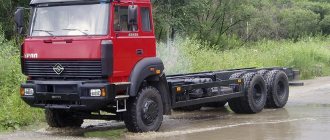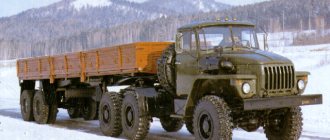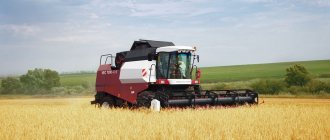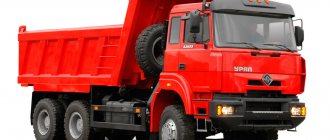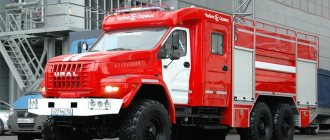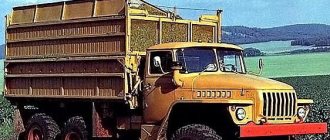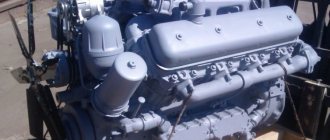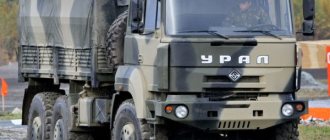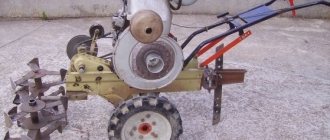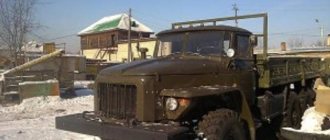It all started back in 1961, when the production of Ural-375 trucks started at a plant in the city of Miass (Ural). Despite the fact that this model was constantly modernized, the truck turned out to be not only reliable, but also durable. However, there were also disadvantages, including working with high octane gasoline. They wanted to remotorize cars back in the 60s. The Urals themselves planned to develop diesel, but due to financial problems their plans failed.
That is why the development of a new engine and gearbox began in Yaroslavl. The diesel engine received a serial number and the name YaMZ-740, while the prototype of the truck began to be called Ural-E4320. Until the fall of 1975, several test tractors and flatbed vehicles were produced. However, production began after the documentation was completed. The entire Ural model range.
Exterior
The body of a domestic car is a metal platform with a folding side at the rear. It is equipped with benches, an awning and removable arches, additional lattice sides. The structure is made in the form of short overhangs, which allows for increased cross-country ability. The total curb weight is 8,265 kg. The weight of the equipment or cargo being transported can reach 6,855 kg, and up to 11.5 tons can be towed.
The standard configuration includes a 3-seater cabin on the frame, which is assembled from thick sheet metal, which is also stamped. As for the glazing, it is made in such a way that the visibility of the driver of the car makes it possible to fully monitor the situation on the road. For this purpose, side rear-view mirrors were made, which are very convenient.
Climate
The Urals are remote from the seas and oceans, so its climate is continental. The region is characterized by sharp temperature changes, sometimes even within a day.
This is due to constantly alternating warm and cold air currents. The wind from the Arctic often brings frost, and the dry southern wind brings warmth. The movement of winds from the west is hindered by the Ural Mountains.
The average temperature in winter varies from -17℃ to -20℃. The average temperature in summer is +19℃. There is a lot of precipitation, especially in mountainous regions.
The Urals are located in the following climatic zones:
- arctic;
- subarctic;
- moderate.
Interior
The presented model is equipped with a cabin with two doors made of metal. It is designed for three people. The driver's seat is adjustable and there is a ventilation system. Some cabin options are equipped with a separate berth. Since the spring of 2009, the Ural-4320 began to be equipped with a new type of cabin made of fiberglass. Operating conditions, controls and seating arrangements have become more comfortable.
Total information
German military all-wheel drive motorcycles gave rise to the spread of such equipment in the USSR in the days after the Great Patriotic War. The Soviet M-72 motorcycle was created for exclusively military purposes, and the Ural series, which still pleases many people with new models, became its continuation.
Initially, motor vehicles became most widespread in rural areas due to accessibility, convenience and reliability. Over time, especially when new Urals began to be equipped with imported parts and were stylized according to current realities, they began to be used in tourism, by bikers, and for simple highway driving.
A large amount of equipment is sent for export. In Europe, no matter what, modern models are highly valued, and some representatives of the series are even intended only for sale abroad.
Specifications
Since the Ural-4320 was originally planned as a vehicle for military service, it received an optimal safety margin and is repairable in any conditions. The simplicity of the design also played an important role. There are enough variations of engines - here you can get 230 hp, 240 hp, and 250 horsepower YaMZ. In principle, you can make a custom-made package with a YaMZ-7601 with 300 horsepower and a 5-speed gearbox.
Not without a hydraulic booster. The engines are equipped with a pre-heater - they fully comply with the Euro-3 standard. The Ural-4320 is capable of taking 300 liters of diesel fuel on board at once, although some models are distinguished by the presence of an assistant for 60 liters. The truck consumes 42 liters of diesel fuel per 100 km at a speed of 60 km/h.
Transmission
The wheel formula is 6x6. 4320 has high cross-country ability, which can be achieved using single-pitch wheels with automated adjustment of air filling of the chambers on all wheels. The suspension installed in front is dependent and rests on semi-elliptical springs with double-acting shock absorbers. There are also dependent ones at the rear and they are located on springs with reaction rods. The Ural-4320 has all axles (there are only 3) driven. The wheels that are in front and which are also controlled by the steering wheel have CV joints. The YaMZ-182 clutch has a friction drive, where the pneumatic amplifier is located, and has one disk with a diaphragm pull-type spring.
With a 2-speed manual transfer case, front-wheel drive is always on. The manual transmission of the Yaroslavl Motor Plant contains 5 gears with a locked center differential, and is perfectly synchronized. So, it allows you to get 10 gears for forward movement and a couple of speeds for reverse. The transfer case contains a center locking differential, which distributes torque between the drive front axle and a pair of drive axles at the rear in a ratio of 1 to 2.
These gearboxes are controlled mechanically. Cardan transmission – 4 cardan shafts. The main gear of the drive axles is double, containing a pair of bevel gears and a pair of cylindrical gears. The robust bumper at the front and rear has been fitted with strong towing devices in the form of hooks and a tow bar on the frame, enhancing the truck's technical capabilities.
Brake system
It includes two systems: a 2-circuit working vehicle and a spare single-circuit vehicle. In addition, there is an auxiliary function of brakes with pneumatic drive from the exhaust system. The braking system is mechanical and has a brake drum on the transfer case. The parking brake design is of a drum type, installed on the output shaft of the transfer case.
Motor
The Ural-4320-10 was made to move by a couple of varieties of power units:
- Diesel eight-cylinder KamAZ-740.10 (also used on LAZ-4202 buses), the power of which was 230 horses, the volume was 10.85 liters;
- Yaroslavsky (YaMZ-226) - a diesel engine with 180 horsepower;
- YaMZ-236NE2 (230 horses) – volume 11.15 liters (four-stroke, turbocharged);
- YaMZ-238M2 (240 horses);
- YaMZ-236BE2 (250 horses);
- YaMZ-7601 (300 horses) – on order.
The KamAZ-740 engine is smaller in size and lighter in weight compared to the YaMZ-238, and it also has a higher crankshaft rotation speed. At low air temperatures, the KAMAZ power unit starts well, which is ensured by the use of a strong starter, batteries whose power has been increased, good motor oil and a starting heater. The power unit is driven by a fuel injection pump (high pressure fuel pump).
YaMZ-238 is a four-stroke engine that has an electric flare device for starting in cold seasons. There is one interesting nuance - before the engine stops operating, it must idle for one or two minutes.
The motors fully meet European Euro-3 standards.
On board, an off-road truck can take about 300 liters of fuel. Some models have an additional 60 liter tank. Diesel fuel consumption in the Urals (with a road train) with engines from the Yaroslavl Motor Plant at a speed of 40 km/h is 31 (36) liters, at 60 km/h – 35 (42). The maximum speed is 85 km/h. When operating on heavy soil, the volume of diesel fuel increases to 50-55 liters. The cruising range is 1040 kilometers, and it can overcome ascents fully loaded to 58%. In addition, the truck can overcome fords, the depth of which is up to 1.5 meters. Specifications
| Modification | engine's type | Engine capacity | Revolutions | Transmission | Acceleration up to 100 km/h, sec. | Maximum speed km/h |
| Ural 4320 10.8 MT | Diesel | 10850 cm³ | 2600 | Mechanical 5st. | – | 85 |
Transportation options
The base for transporting various types of goods or people is made of metal. It has an opening side at the back and lift-up seats located on the sides. You can add sides on both sides, install arches and cover with an awning. There are Ural-4320 configurations that are supplied with material made of wood. The board has a solid or lattice shape. The number of passengers that can be transported can vary from 27 to 34 seats.
The maximum weight that the Ural can transport is 10,000 kg. The structure of the Ural car is made in such a way that the power unit is located in front, the hood rises up, and there are wide flat wings on the side that protect the driver's cabin from the penetration of dirt when driving off-road, for example.
Weaknesses of the IMZ-8.103-10 (IMZ-8.103-30, M-67-36) engine of the Ural motorcycle
- Foot starter (kickstarter);
- Gas and clutch cables;
- Generator;
- Carburetors;
- Cylinder heads;
- Reverse gear (gearbox).
More details about the weak points of the motor...
Foot starter (kickstarter)
The foot starter of the IMZ-8.103-10 engine is a weak point due to the slippage of the pawl. The malfunction is eliminated after dismantling the gearbox and disassembling it with rearranging the pawl with the other side or replacing it. I have an assumption that the metal of the dog is of low hardness. On the other hand, if the pawl is made harder, the gear will fail. You need to choose the golden mean.
Throttle and clutch cables
The clutch control and fuel supply cables are a weak point due to their short service life. To put it simply, they tear, and before that they stretch, which makes it necessary to adjust the timing of the supply of the fuel mixture, as well as the clutch.
Generator
The generator does not run for a long time.
Carburetors
Gasoline gets into the floats, after which the cylinder is filled with gasoline. In addition, carburetors are not matched to these engines; half of the fuel goes to waste, which is not economical. It would be nice if the engine had one carburetor instead of two.
Cylinder heads
Do not overtighten the spark plug heads; the threads break off quite easily. You cannot overheat the engine, the result will be clearly visible on the heads, the studs are pulled out, leading to the landing plane of the heads. If you are unable to avoid breaking the spark plug thread, contact a familiar turner; he will be happy to repair it and install a steel threaded bushing for a modest fee. I can recommend the same for wear of valve seats and chamfers. It is much cheaper to repair heads than to buy new ones; a good turner can do this in no time.
Reverse gear (gearbox)
The reverse gear does not work for a long time due to the rapid wear of the reverse gear in the gearbox.
Modifications
There are a considerable number of Ural-4320 off-road trucks, and each of them has its own feature:
- Ural-4320-01 - was produced in 1986. It is dominated by an improved version of the cabin, unlike the previous version, a different platform and gearbox. Went along with the Kamazov engine;
- Ural-4320-10 - produced with a 6-cylinder power unit YaMZ-236, which produces 180 horsepower. The vehicle was designed for transporting various cargoes, people and towing trailers on and off-road. The installed winch always helped out when getting stuck (which happened very rarely), it could be designed for a distance of up to 65 m;
- Ural-4320-31 - released in 1993 with an 8-cylinder power unit, the power of which increased to 240 horses. Moreover, it comes with improved power density settings;
- Ural-4320-30 - a truck with an increased wheelbase and increased load capacity;
- Ural-4320-41 is a truck with a Yaroslavl plant engine (YaMZ-236NE2), produced in 2002. It met Euro-2 standards and had 230 horsepower;
- Ural-4320-40 – modification 4320-41, only with an extended base;
- Ural-4320-44 - produced in 2009 - the same version 4320-41, only differing in the cabin, which has increased comfort;
- Ural-4320-45 – Ural-4320-44 truck, with an extended wheelbase;
- Ural-4320-48 - comes with the YaMZ-7601 power unit. This version of the machines was specially produced for the installation of special equipment.
It turns out that in different versions of the Ural-4320, the engine power was radically different. There was a particularly significant appearance in 2009 of a new version of the truck, where the cabin was equipped with additional comfort. For example, the hood was made of fiberglass. Moreover, a stylish unique plumage appeared. Starting this year, the auto company is worried not only about the off-road properties of the truck, but also about the convenience of staying in the driver’s cabin, which has not received so much attention before.
It is worth saying that when assembling the truck, the engineers thought about the person who would drive the Russian car. The steering wheel was not without a hydraulic booster. The cabin had a pretty good heater. The driver's seat is adjustable in three directions - height, length and adjustable backrest tilt. There are headrests and armrests, making the ride more comfortable. We started installing seat belts.
The interior began to be made from materials that provide good noise and heat insulation. The instrument panel has a convenient location. All sensors and meters are easy to read, and the necessary buttons and switches can be used without leaving the driver’s seat. There is also a rather large and rational glove compartment, and a shelf for storing papers and other things and property. Under the passenger seats there is a tool chest. It is possible to equip the car with a sleeping place.
Strollers
“Ural Tourist-T” is an updated model that has become even more versatile. The motorcycle is capable of carrying 3 passengers and a load of up to two hundred and eighty-five kilograms.
Along with this version, a paramilitary "Tourist" was released, which was called "Ural Gear Up". Equipment for economical fuel consumption was installed in it. Another modification at this time was the “Ural Sportsman (Patrol)” with all-wheel drive. The Ural Retro modification was specially released for the model of the fifties. But it was fully equipped with modern imported parts. In the 60s and 70s, the Ural M-63 was fashionable, which was sold only with a sidecar. Even by modern standards, such a Ural motorcycle is considered very heavy. Its technical characteristics allowed it to be used even as a tractor. In those days, legends were made about its cross-country ability. Ground clearance was 125 millimeters when fully loaded. And this is a pretty good indicator, given the wheelbase of 1435 millimeters. With a torque of 44 newtons per meter, it had a power of 21 horsepower.
The stroller was completed very successfully. Therefore, until the 80s it existed practically unchanged.
Price and options
Over its long history, many different configurations and modifications of this truck have appeared. Of course, most of the cars went to the needs of the army. In 2011, an Indian company created the Casspir Mk6 armored car based on the Ural-4320. During testing, the tuned truck withstood a powerful explosion equal to 21 kg of TNT. But let's return to pricing policy. As for the cost of the Russian off-road truck, Ural-4320, the plant has established a pricing policy that starts from 1,700,000 rubles for a vehicle with a previous generation cab and a YaMZ-236NE2 engine (230 horsepower).
For the Ural-4320 car with the latest cabin and the same YaMZ-236NE2 power unit (230 horses) you will need to pay 1,710,000 rubles. For the extended Ural chassis and increased load capacity, you will have to pay 1,880,000 rubles. A flatbed model of the Urals, covered with an awning and with a winch, the same engine for 230 horses, costs 1,790,000 rubles. Finally, the Ural-4320 flatbed, with a long wheelbase and a Yaroslavl engine with 230 horsepower, can be purchased from 1,950,000 Russian rubles.
Soils
The Urals are characterized by a variety of soils. This is again explained by the large latitudinal extent.
In the north of the region there is a tundra-gley layer of soil. To the south there are soddy-podzolic soils, and gley-podzolic soils are also found. Black soils appear in the south of the Urals. At the same latitude, behind the Ural ridge, there are larger quantities of leached chernozems. There are also patches of gray forest soils.
In the mountainous regions of the Urals, almost all soils are similar. The most common types there are:
- brown-taiga;
- gray forest;
- podzolic.
Let's sum it up
Model 4320 Ural became a successful successor to the gluttonous 375 D, which consumed up to 70 liters of gasoline per 100 km. Even today, this car evokes some kind of wild delight by its appearance alone. It can transport absolutely any cargo and travels where the road is forever closed to many SUVs. The 6x6 wheel arrangement and simply fantastic ground clearance of 360 mm lays the foundation for producing the 4320 Ural for many years to come.
We advise you to read the article: “Ural” - the history of the automobile plant
Features of nature
The Urals stretch from north to south, so the nature in each of its regions is different.
The Ural Mountains represent not only a feature of the region's topography. They also play an important role in nature, acting as a barrier to some plant species.
This means that the plant world of the Trans-Urals differs from the plant world of the Cis-Urals.
Ural-4320 photo
Read further:
We recently compiled the TOP 5 most reliable modern engines
ZIL-4331
Dodge Charger Daytona
Kia GT4 Stinger sports car expected by 2022
Ural-6370
Ural-44202


